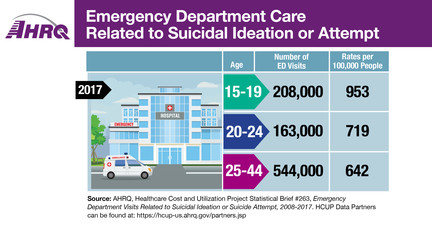| November 17, 2020, Issue #739  Access more data on this topic in the associated statistical brief. Adding patients' photographs to the banner of electronic health records (EHRs) enhanced patient identification and significantly reduced wrong-patient order errors in a hospital emergency department, according to an AHRQ-funded study in JAMA Network Open. Researchers evaluated more than 2.5 million nursing, medication, diagnostic and other orders for about 72,000 hospital patients. They used the rate of retract-and-reorder events as the outcome measure and noted that this rate was 186 per 100,000 orders for patients with no photograph in their EHRs and 133 per 100,000 orders for patients with photographs. Unlike previous interventions that interrupt clinicians, this solution did not add to practitioners' time burden or risk of alert fatigue, according to researchers. Access the abstract. About 55 percent of private-sector workers who received single-coverage health insurance in 2019 were enrolled in high-deductible plans, according to a new chartbook from AHRQ. The percentage of employees in high-deductible plans has grown steadily since 2006, when only about 11 percent of private-sector workers with single coverage were in such plans. These findings are in the Medical Expenditure Panel Survey Insurance Component 2019 Chartbook, which presents results from AHRQ's annual survey of private-sector employers. The chartbook presents national and state-level estimates of employer-sponsored insurance, including offered plans, costs, employee eligibility, and number of enrollees. New findings quantify increases in the percentage of employees working at establishments where insurance was offered, as well as employees' share of premiums and deductible amounts. Access the chartbook and an interactive data visualization tool that allows users to explore data on employee cost sharing, including geographic variations.  A safety toolkit funded by AHRQ helped hospitals reduce patient falls overall by 15 percent and falls resulting in injuries by 34 percent, according to a study published in JAMA Network Open. Researchers evaluated more than 37,000 patients in 14 adult medical units in three academic medical centers between September 2015 and November 2016. Fall risks in those patients were reduced by a nurse-led toolkit that focused on strategies to engage patients and families in the fall prevention process throughout hospitalization. The Fall T.I.P.S. (Tailoring Interventions for Patient Safety) Toolkit provided solutions such as laminated posters near patients' beds and tailored prevention plans in patients' electronic health records and printed out or displayed on computer screensavers. Access the article abstract. | AHRQ's Patient Safety Network (PSNet) highlights journal articles, books and tools related to patient safety. Articles featured this week include: Review additional new publications in PSNet's current issue or access recent cases and commentaries in AHRQ's WebM&M (Morbidity and Mortality Rounds on the Web). | AHRQ in the Professional Literature Rhythm control versus rate control in patients with atrial fibrillation and heart failure with preserved ejection fraction: insights from Get With The Guidelines-Heart Failure. Kelly JP, DeVore AD, Wu J, et al. J Am Heart Assoc. 2019 Dec 17;8(24):e011560. Epub 2019 Dec 10. Access the abstract on PubMed®. The epidemiology of respiratory failure in the United States 2002-2017: a serial cross-sectional study. Kempker JA, Abril MK, Chen Y, et al. Crit Care Explor. 2020 Jun 10;2(6):e0128. Access the abstract on PubMed®. Comparison of accuracy of prediction of postoperative mortality and morbidity between a new, parsimonious risk calculator (SURPAS) and the ACS Surgical Risk Calculator. Khaneki S, Bronsert MR, Henderson WG, et al. Am J Surg. 2020 Jun;219(6):1065-72. Epub 2019 Jul 29. Access the abstract on PubMed®. Reference chart for knee flexion following total knee arthroplasty: a novel tool for monitoring postoperative recovery. Kittelson AJ, Elings J, Colborn K, et al. BMC Musculoskelet Disord. 2020 Jul 22;21(1):482. Access the abstract on PubMed®. Do financial incentives matter? Effects of Medicare price shocks on skilled nursing facility care. He D, McHenry P, Mellor JM. Health Econ. 2020 Jun;29(6):655-70. Epub 2020 Feb 8. Access the abstract on PubMed®. Security and privacy risks associated with adult patient portal accounts in US hospitals. Latulipe C, Mazumder SF, Wilson RKW, et al. JAMA Intern Med. 2020 Jun;180(6):845-9. Epub 2020 May 4. Access the abstract on PubMed®. Surface perturbation training to prevent falls in older adults: a highly pragmatic, randomized controlled trial. Lurie JD, Zagaria AB, Ellis L, et al. Phys Ther. 2020 Jul 19;100(7):1153-62. Access the abstract on PubMed®. Trends in severe pediatric emergency conditions in a national cohort, 2008 to 2014. Michelson KA, Hudgins JD, Burke LG, et al. Pediatr Emerg Care. 2020 Nov;36(11):e620-e1. Access the abstract on PubMed®. Contact Information For comments or questions about AHRQ News Now, contact Bruce Seeman, (301) 427-1998 or Bruce.Seeman@ahrq.hhs.gov. |





No comments:
Post a Comment